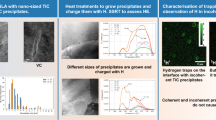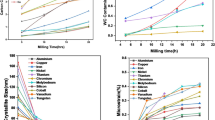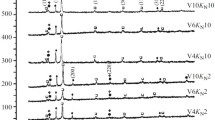Abstract
When metals or alloys are subjected to electrical discharges in a dielectric fluid, the molten metal frequently reacts with the fluid or with ionic fragments generated from the dielectric by the discharge. When hydrocarbon fluids are used as dielectrics, the reaction products are metal carbides. These carbides are present both as surface layers on the metal samples and as fine powder particles produced when material is ejected from the surface by the sparks. Results are reported here on a study of the formation of fine carbide powder by the spark machining of Ti, Zr, and W. Spark machining of Ti and Zr produced the NaCl structure carbide expected of these metals, though under some machining conditions the powder produced by the machining also contained fine dispersion of the parent metal or graphite. Machining of W produced hexagonal structure W2C and WC in both the NaCl and the hexagonal structural forms. X-ray diffraction studies showed that the carbon concentration of these powders depended upon the frequency and polarity of the applied current pulses and upon other processing variables. The X-ray studies and scanning electron microscopy of the powders and of the surfaces from which they were generated showed that carburization reactions occurred both in the molten pools produced on the sample surfaces by the electric discharges and within fine particles after they were ejected from the surfaces.
Similar content being viewed by others
References
T. Yamaguchi and Narita:IEEE Trans. Magn., dy1977, MAG-13, p. 1621.
A. E. Berkowitz and J. L. Walter: inRapid Solidification Processing, II, R. Mehrabian, B. H. Kear, and M. Cohen, eds., Claitor’s Publication Div., Baton Rouge, LA, 1980, p. 294.
O.I. Pisarenko: Candidate’s Thesis, Mendeleev Moscow Chemical Technical Institute, Moscow, 1964.
G. V. Lisichkin, O. I. Pisarenko, V. Yu. Khinchagashvili, and M.A. Lunina:Russian Journal of Inorganic Chemistry, 1977, vol. 22, p. 619.
V. N. Filimonenko and V.I. Marusina:Elektronnakila Obrabolka Materialov, 1980, vol. 4, no. 94, p. 47 (in Russian).
M. A. Lunina and Yu. A. Novozkilov:Coll. J. USSR, 1969, vol. 31, p. 370.
N.C. Welsh:J. Inst. Metals, 1959–60, vol. 88, p. 103.
H.S. Rawdon:Trans. AIME, 1924, vol. 70, p. 37 (discussion).
R. P. Elliott:Constitution of Binary Alloys, First Supplement, McGraw-Hill, New York, NY, 1965, p. 232.
H. Bittner and H. Goretzki:Mh. Chem., 1962, vol. 93, p. 1000.
J.D. Ayers:Metall. Trans. A, 1983, vol. 14A, p. 5.
F. A. Shunk:Constitution of Binary Alloys, Second Supplement, McGraw-Hill, New York, NY, 1969, p. 168.
Author information
Authors and Affiliations
Rights and permissions
About this article
Cite this article
Ayers, J.D., Moore, K. Formation of Metal Carbide Powder by Spark Machining of Reactive Metals. Metall Trans A 15, 1117–1127 (1984). https://doi.org/10.1007/BF02644706
Received:
Published:
Issue Date:
DOI: https://doi.org/10.1007/BF02644706




